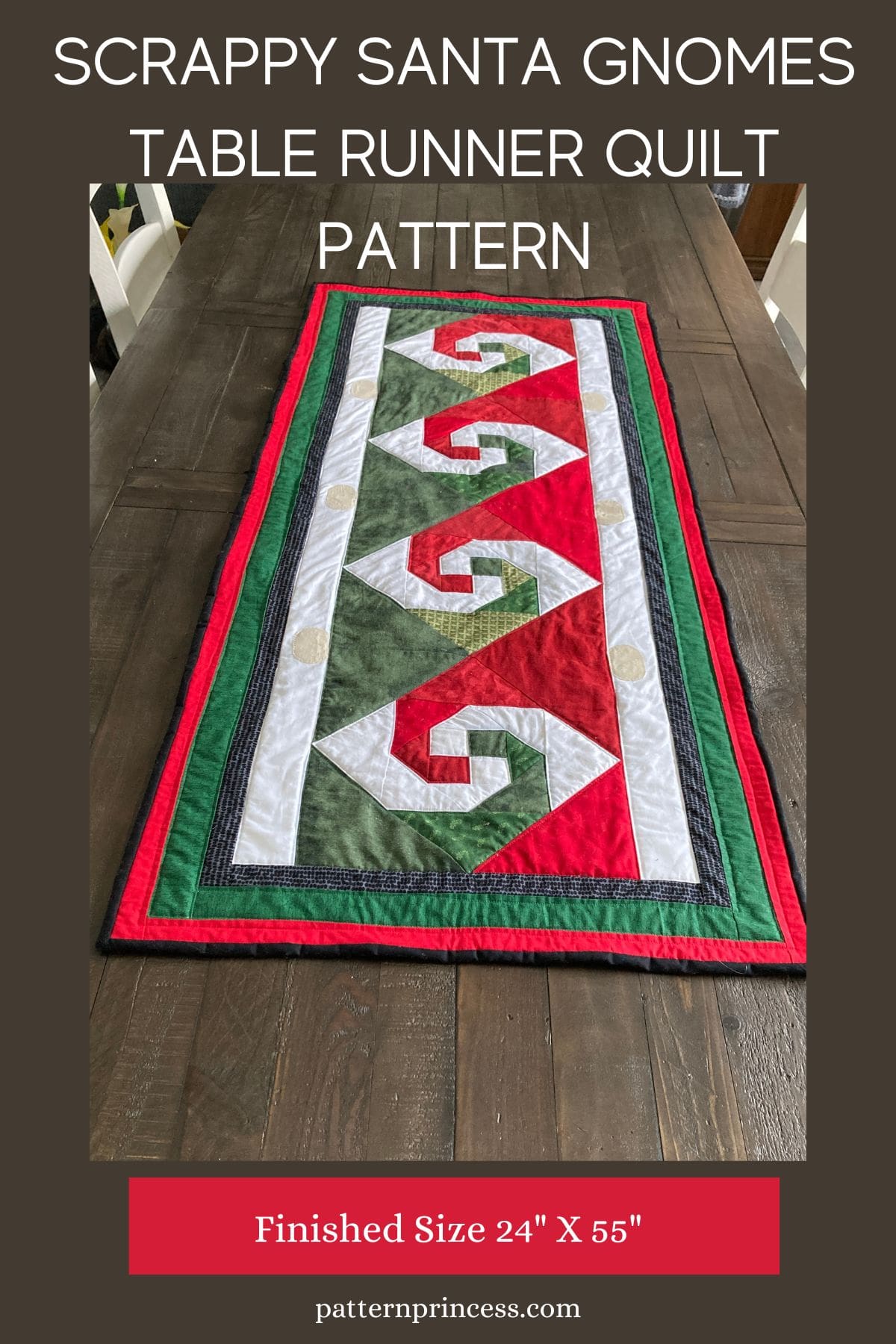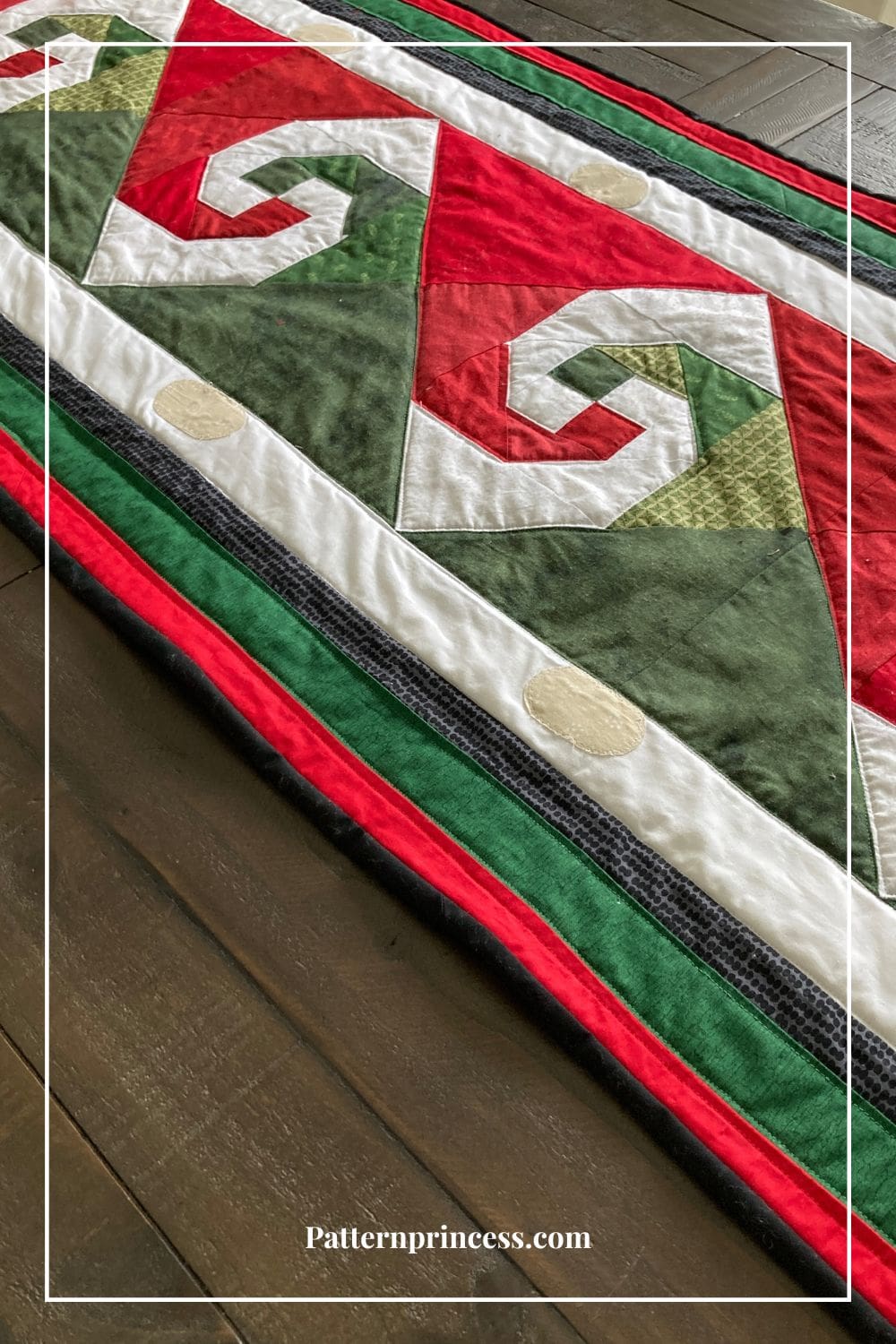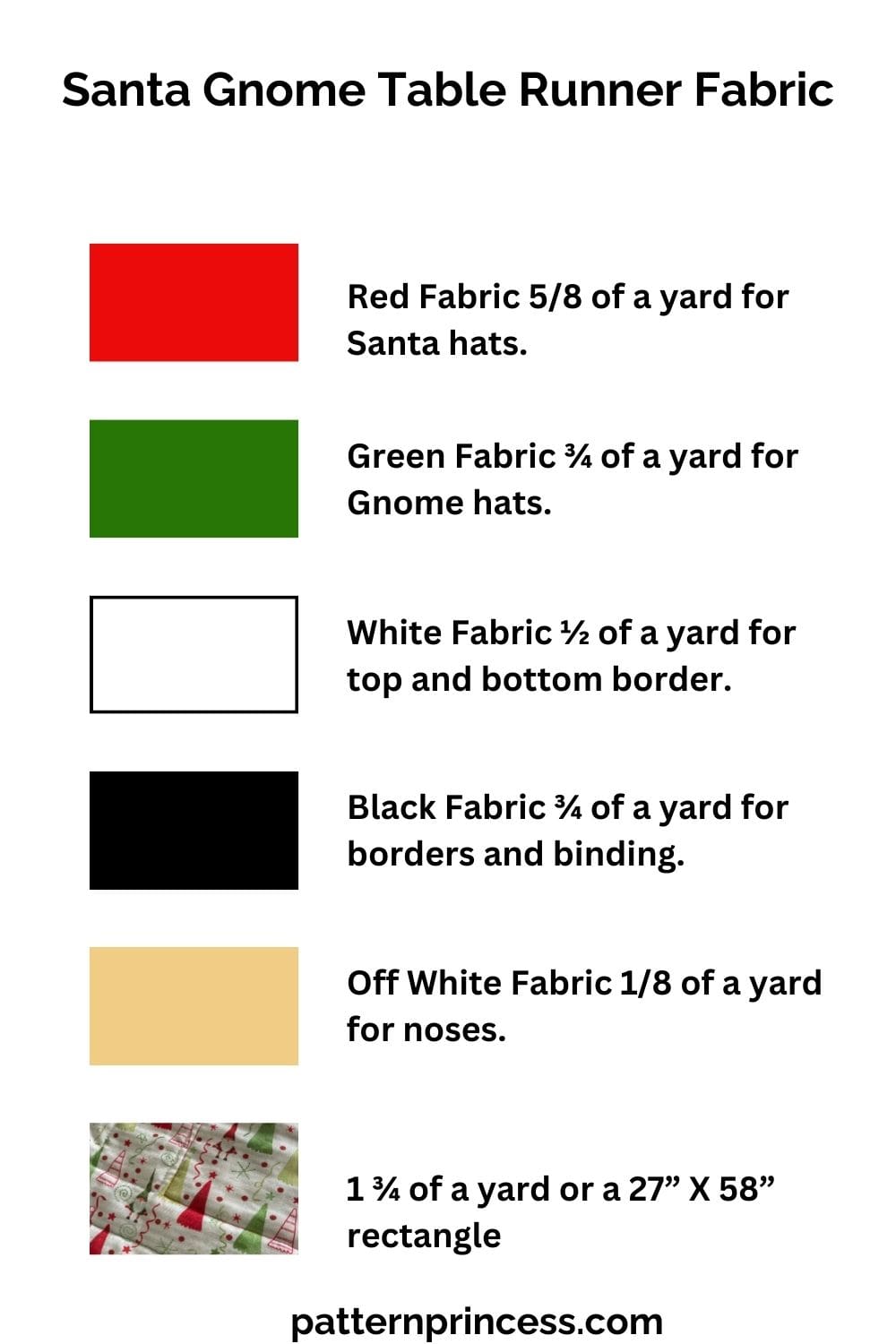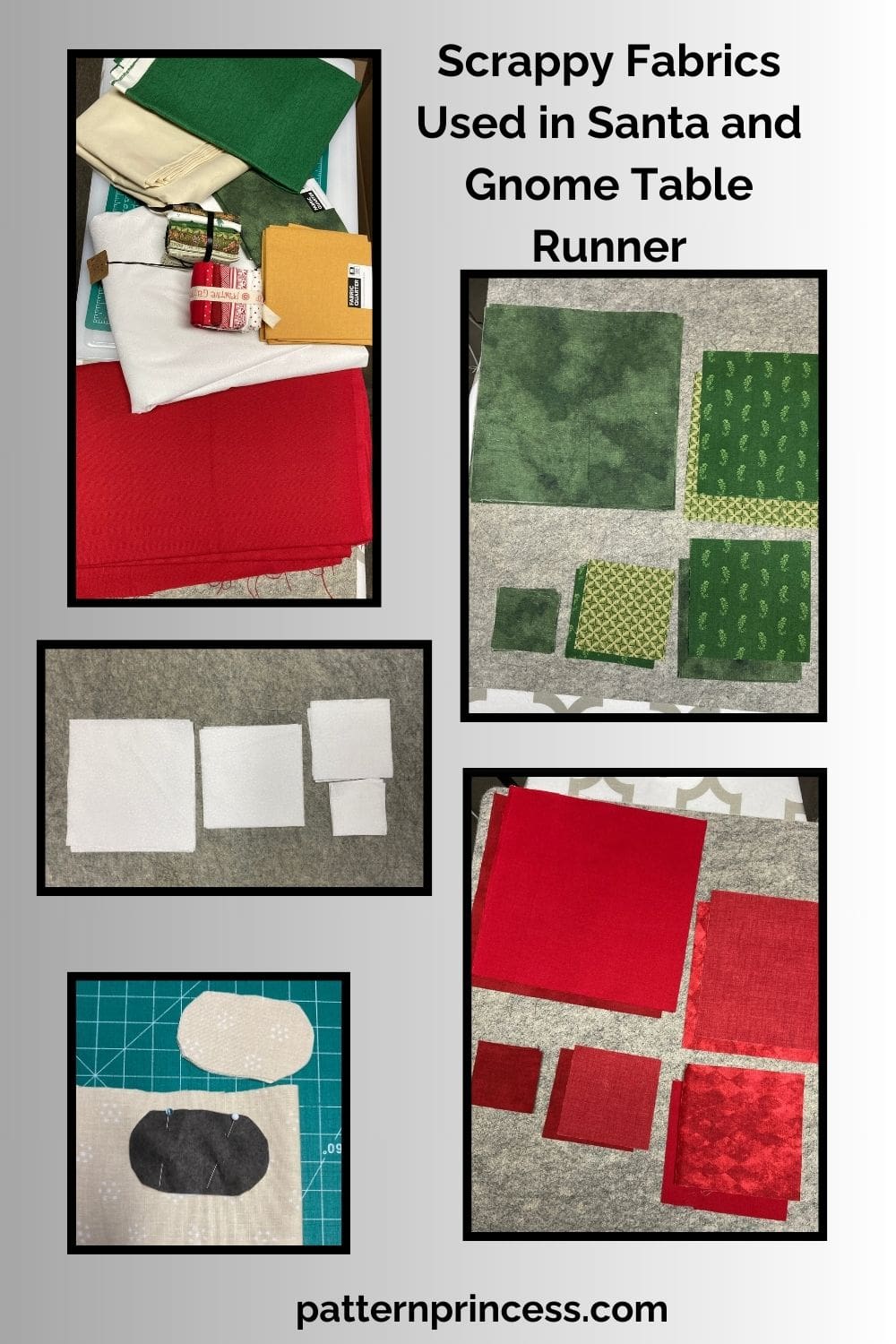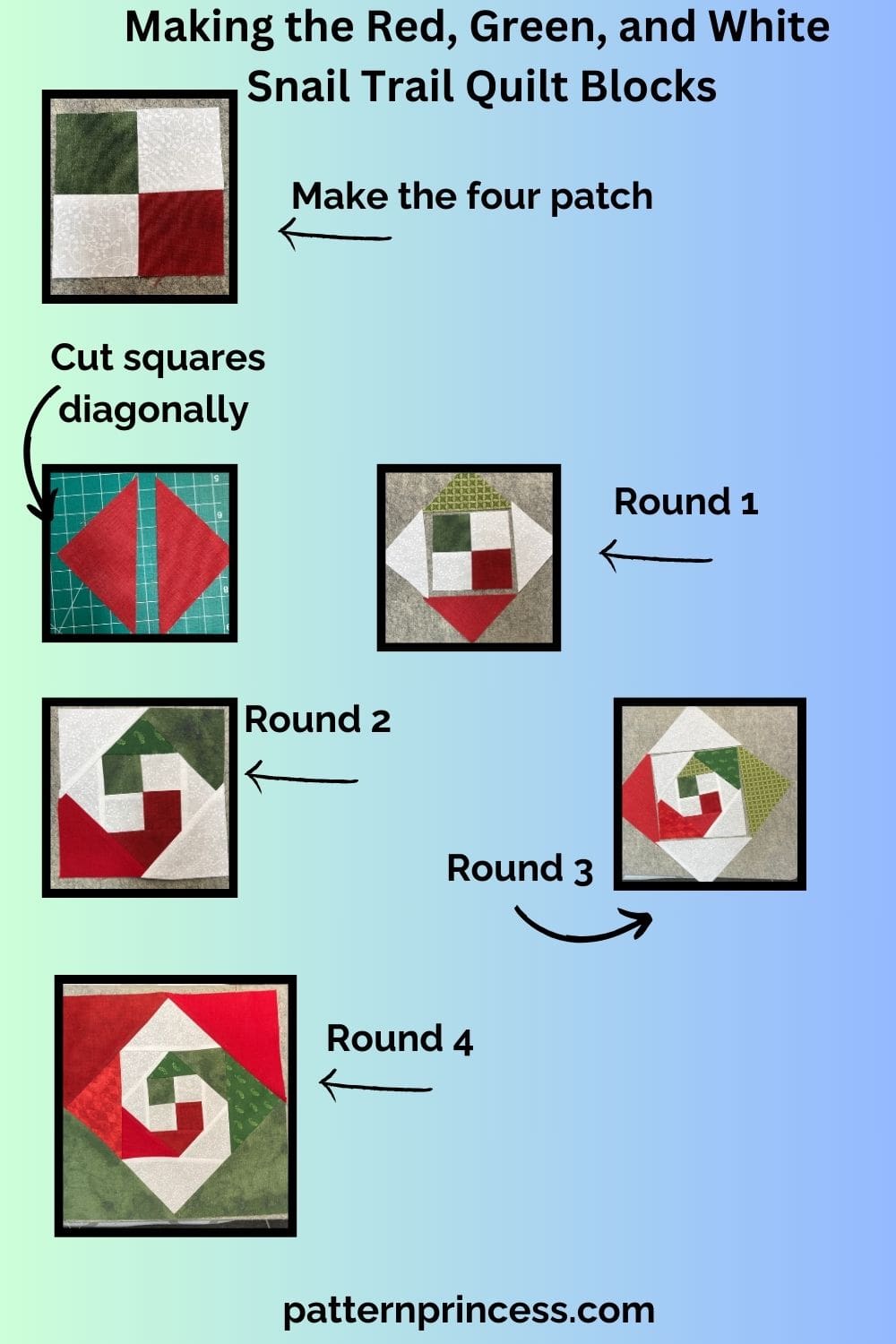Last updated on July 4th, 2024 at 11:29 pm
Bringing Whimsy to Your Holiday Table with Scrappy Santa Gnomes Table Runner Quilt Pattern. As the holiday season approaches, there’s a special kind of magic that fills the air.
From the twinkle of festive lights to the sweet aroma of freshly baked treats, this time of year is undeniably enchanting. And what better way to embrace that enchantment than by adding a touch of homemade charm to your holiday decor?
Holiday Gnomes and Santas
If you’re a quilting enthusiast or looking to try your hand at a delightful DIY project, we’ve got just the thing to make your table setting extra special this year. This whimsical and heartwarming quilted table runner captures the essence of the holiday season in a creative and unique way, featuring a stunning 12-inch snail trail quilt block design in red, white, and green fabrics.
Post contains affiliate links, and we earn commissions if you shop through the links on this page. For more information, please read the disclosure section under the About Us page.
Imagine your holiday table adorned with this charming one-of-a-kind creation, where on one side, you’ll find a row of cheerful green gnome hats complete with their adorable noses. On the other side, you’ll discover a line of vibrant red Santa hats, each with its own nose. This delightful blend of Santa and gnomes is a surefire way to spread joy and merriment during your festive gatherings.
Snail Trail Quilt Block
Previously, I posted a step-by-step guide on how to sew the snail trail quilt block. Since then, I have made two table runners.
One was a Witch Hat Halloween Table Runner, which is a fun Halloween-inspired quilt pattern. This fun table decoration uses purple, black, and orange fabrics. Just 4 quilt blocks and three borders and you have a lovely handmade fall decoration.
Now you can add a little touch of scrappy, quilted magic to your holiday decor. Whether you’re an experienced quilter or a confident beginner looking for a fun and rewarding project, this pattern is perfect. Let’s dive into the world of Scrappy Santa Gnomes and make this holiday season an unforgettable one.
Directions: Scrappy Santa Gnomes Table Runner Quilt Pattern
Quilting Skill Level
Easy – Confident Beginner
Quilt Pattern Uses 4 finished size 12-inch finished Snail’s Trail Quilt Blocks. Along with a top and bottom border and 3 Borders around.
Finished Table Runner Measurements
24 X 55 inches finished.
Materials
Red Fabric 5/8 of a yard for Santa hats.
Green Fabric ¾ of a yard for Gnome hats.
White Fabric ½ of a yard for top and bottom border.
Black Fabric ¾ of a yard for borders and binding.
Off White Fabric 1/8 of a yard for noses.
**The fabric estimates assume that the long strips are pieced using 42-44” wide fabric.
Fusible Web Regular Weight for the noses, just one package.
Backing Fabric 1 ¾ of a yard or a 27” X 58” rectangle
Batting Fabric 27” X 58” rectangle
Binding 2 ½” X 190” strip
I used 5 black jelly roll strips joined; however, you can cut your own 2 ½” strips and join them to make the binding.
Thread
Equipment and Tools
- Rotary Cutter
- Quilting Ruler
- Cutting Mat
- Rotating Cutting Mat
- Iron
- Ironing Board or Pressing Mat
- Pins
- Clips
- Sewing Machine
- Disappearing fabric marker
- My Favorite Quilting Supplies
Santa Gnomes Table Runner Pattern Notes
For the larger triangles, mark the center of each diagonal and line it up carefully to keep your block square.
Double check the placement of each round of triangles before stitching to keep the trail going in a spiral. Refer to the photo for directions.
Trim the outside corners of the triangles after each round as they will extend slightly beyond the outside edges of the square.
Sew fabric together with right sides together using ¼-inch seam allowance. Unless otherwise noted. Pin or clip your pieces together before sewing them to ensure proper seam alignment.
The directions for this quilt are for rotary cutting, machine piecing, machine quilting, and hand sewing on the binding to the back.
Begin by Making the Snail Trail Quilt Blocks
Fabric Cutting Directions:
You will need 4, 12” X 12” finished quilt blocks for this project. (12 1/2” X 12 1/2” unfinished)
Before starting to make the table runner, cut the following from the fabrics:
Snail Trail Squares
- 2” X 2” square, cut 4 Red, 4 Green, and 8 White.
- 3” X 3” square, cut 2 Red, 2 Green, 4 White.
- 3 7/8” X 3 7/8” square, cut 2 Red, 2 Green, 4 White.
- 5 1/8” X 5 1/8” square, cut 2 Red, 2 Green, 4 White.
- 6 7/8” X 6 7/8” square, cut 4 Red and 4 Green.
Sashing
- 3” X 48 ½” rectangle, cut 2 White.
- Noses 2” oval, cut 8 out of the Off White fabric.
Black Border
- 1 ½” X 17 ½”, cut 2 Black strips.
- 1 ½” X 50 ½”, cut 2 Black strips or piece as needed for the length.
Green Border
- 2” X 19 ½”, cut 2 Green strips.
- 2” X 53 ½”, cut 2 Green strips or piece together for the length.
Red Border
- 1 ½” X 22 ½”, cut 2 Red strips.
- 1 ½” X 55 ½”, cut 2 Red strips or piece together strips for length.
Begin Snail Trail Quilt Block Pattern
- Refer to the Photo for directions.
- Work all four quilt blocks the same.
Start with the Four Patch Square in the Middle.
Starting with the 2-inch squares, using a ¼” seam allowance with the right sides together. Sew a red fabric to a white fabric with the right sides together. You now have 2 units. Press the seam allowances toward the red squares.
Repeat this process for the next three red and white 2” X 2” squares.
Next join the green and white 2” X 2” squares together.
Press the seam allowances to the green squares.
You should have 4, 2 patches of red and white and 4, 2 patches of green and white complete.
Next make the center four patches for all 4 quilt blocks.
Line up the two units of squares so the colors are opposite to form a four patch block. One red and white and one green and white. Sew them right sides together with a 1/4″ seam allowance, nesting the center seams. Press the seam open.
Complete this process for the center four patches in the next 3 quilt blocks.
Round 1
Take the 3″ squares and cut them diagonally into two triangles each.
Use the diagram for the fabric color placement for the triangles.
Using the green color. Line up the first triangle with the center, right sides together on the side with the green square in the top left and the white square in the top right as shown in the diagram.
You’ll want the cut diagonal edge to be along one side of the four patch on the outer edge. The corner point should be lined up with the center seam of the four patch.
Sew with a 1/4″ seam allowance. Press the seams allowances toward the triangles.
On the opposite side of the four patch, add the red triangle right sides together, making sure that the corner point is lined up with the center seam of the four patch. The cut diagonal edge should be along the side of the four patch.
Sew with a 1/4″ seam allowance. Press the seams allowances toward the triangles.
Next add the two white triangles on each side with the right sides together. Again, the corner point should line up with the center seam of the four patch. The cut diagonal edge should be along the side of the four patch.
Sew with a 1/4″ seam allowance. Press the seams allowances toward the triangles.
Complete this process for the next 3 quilt blocks.
Trim up the edges before going to the next round.
Round 2
Take the 3 7/8″ X 3 7/8” squares cut them diagonally into two triangles each.
Use the diagram for the fabric color placement for the triangles.
Pro Tip. As you continue to work around the four patch, to help with placement of the triangles, keep the four patch in the original placement with the green square in the top left and the white square in the top right. The lower left will be white and lower right is the red patch.
Using the green color. Line up the first triangle with the center, right sides together on the upper right side. The side where the green triangle is on the top and the white triangle is on the right as shown in the diagram.
Again, the cut diagonal edge is along the side of the square outer edge and the corner point will line up with the center seam.
Sew with a 1/4″ seam allowance. Press the seams allowances toward the triangles.
On the opposite side of the square, add the red triangle right sides together, making sure that the corner point is lined up with the center seam of the four patch. The cut diagonal edge should be along the side of the four patch.
Sew with a 1/4″ seam allowance. Press the seams allowances toward the triangles.
Next add the two white triangles on each side with the right sides together. Again, the corner point should line up with the center seam of the four patch. The cut diagonal edge should be along the side of the four patch.
Sew with a 1/4″ seam allowance. Press the seams allowances toward the triangles.
Complete this process for the next 3 quilt blocks.
Trim up the edges before going to the next round.
Round 3
Take the 5 1/8″ X 5 1/8” squares cut them diagonally into two triangles each.
Pro Tip. For this and subsequent rounds, mark the center of the diagonal line on the wrong side of each triangle. I like to use a marking pen that disappears with the heat of an iron. A small mark within the seam allowance is enough of a guide. Use the marked line to center the diagonal edge with the previous round of triangles.
Use the diagram for the fabric color placement for the triangles.
Using the green color. Line up the first triangle with the center, right sides together on the right side. The side where the green triangle is on the top right and the white triangle is on the lower right as shown in the diagram.
Sew with a 1/4″ seam allowance. Press the seams allowances toward the triangles.
On the opposite side of the four patch, add the red triangle right sides together, making sure that the dot is lined up with the center.
Sew with a 1/4″ seam allowance. Press the seams allowances toward the triangles.
Next add the two white triangles on the top and bottom with the right sides together.
Sew with a 1/4″ seam allowance. Press the seams allowances toward the triangles.
Complete this process for the next 3 quilt blocks.
Trim up the edges before going to the next round.
Round 4
This is the last round, and you will only be adding red and green triangles.
Take the 6 7/8 X 6 7/8” squares cut them diagonally into two triangles each.
Use the diagram for the fabric color placement for the triangles.
Using the green color. Line up the first triangle on the bottom right side with the right sides together.
Sew with a 1/4″ seam allowance. Press the seams allowances toward the triangles.
Place the next green triangle on the bottom left side. Repeat the steps for sewing and pressing.
Next, place a red triangle on the top right side. Repeat the steps for sewing and pressing.
Last, place a red triangle on the top left side. Repeat the steps for sewing and pressing.
Trim the edges.
Sewing the Scrappy Santa Gnomes Blocks Together
Place all blocks facing the same direction. You should see the witch hats take shape as you align the squares.
Sew each square together with the right sides together using ¼” seam allowance. Press the seams to one side or open.
Adding the Top and Bottom White Sashing
For this step, use the following fabrics.
- 3” X 48 ½” rectangle, cut 2 White.
- Noses 2” oval, cut 8 out of the Off White fabric.
Place a white sashing piece on the top of the four blocks you just sewed together with the right sides together. Pin in place. Sew with a ¼” seam allowance.
Press seams to the outside.
Place the other white sashing strip on the bottom of the blocks with the right sides together. Sew together using ¼” seam.
Press seams to the outside.
Preparing the Noses
Cut out the nose template or make your own nose about a 2” oval. They don’t have to be perfect as each Gnome and Santa can have a unique nose.
You will need a total of 8 noses. I cut a 4” X 24” strip of fabric and the same size of the fusible webbing. Following the package directions, iron the fusible webbing onto the back of the fabric. Let cool.
Cut out 8 noses out of the off white fabric.
Place a nose under each Gnome hat and each Santa hat on the white sashing. Again, following the package directions, peel off the backing of the fusible webbing and iron to adhere.
Next sew around each nose to secure. You can use a zig zag stitch or a straight stitch. I went around each one twice.
Three Borders to Complete the Table Runner Quilt Top
Black – Border 1
Cut the sashing pieces.
1 ½” X 17 ½”, cut 2 Black strips. For the vertical sides.
1 ½” X 50 ½”, cut 2 Black strips for the horizontal top and bottom.
Black Vertical Sashing Pieces on the Sides
Using the 2 vertical side pieces of sashing, pin on the sides of the quilt top with the right sides together. Using ¼-inch seam allowance, sew 1 sashing strip to each side of the quilt.
Press all seams to the outside or open.
Horizontal Sashing Pieces on the Top and Bottom
Using the 2 horizontal pieces of sashing, pin on the top and bottom of the quilt top with the right sides together. Using ¼-inch seam allowance, sew 1 sashing strip to each side of the quilt.
Green Fabric – Border 2
Cut the sashing pieces.
2” X 19 ½”, cut 2 Green strips for the sides.
2” X 53 ½”, cut 2 Green strips for the top and bottom.
Green Vertical Sashing Pieces on the Sides
Using the 2 vertical side pieces of sashing, pin on the sides of the quilt top with the right sides together. Using ¼-inch seam allowance, sew 1 sashing strip to each side of the quilt.
Press all seams to the outside or open.
Horizontal Sashing Pieces on the Top and Bottom
Using the 2 horizontal pieces of sashing, pin on the top and bottom of the quilt top with the right sides together. Using ¼-inch seam allowance, sew 1 sashing strip to each side of the quilt.
Red Fabric – Border 3
Cut the sashing pieces.
1 ½” X 22 ½”, cut 2 Red strips for the sides.
1 ½” X 55 ½”, cut 2 Red strips for the top and bottom.
Red Vertical Sashing Pieces on the Sides
Using the 2 vertical side pieces of sashing, pin on the sides of the quilt top with the right sides together. Using ¼-inch seam allowance, sew 1 sashing strip to each side of the quilt.
Press all seams to the outside or open.
Horizontal Sashing Pieces on the Top and Bottom
Using the 2 horizontal pieces of sashing, pin on the top and bottom of the quilt top with the right sides together. Using ¼-inch seam allowance, sew 1 sashing strip to each side of the quilt.
Press all seams to the outside or open.
Backing and Batting
Backing Fabric 1 ¾ of a yard or a 27” X 58” rectangle
Batting Fabric 27” X 58” rectangle
Binding 2 ½” X 190” strip
I used 5 black jelly roll strips joined; however, you can cut your own 2 ½” strips and join them to make the binding.
The backing fabric and the batting should be a few inches larger all the way around than the quilt top.
Lay the backing fabric on a flat solid surface with the right side down facing out. Smooth out any wrinkles. Use painters’ tape or masking tape to secure the edges of the fabric down. This will help hold it in place and reduce the chance of a wrinkle developing as you place the next two layers.
Next, center the batting on top of the backing fabric smoothing out any wrinkles.
Finally, place the table runner top on the batting, centering it with the right side up. Smooth out any wrinkles.
Pinning the Layers Together
Once you have the top fabric all smoothed out, baste all three layers together using large safety pins. Use a good quality 1 ½” stainless steel pin for this.
Put a pin in each corner and around the entire quilt about every 5-6 inches or so through all three layers.
This holds things in place, so they don’t move around while you are sewing the layers together using a quilting design of your choice.
Alternatively, you could use fabric spray glue to baste the layers together rather than pinning.
This is how I quilted the layers together. I sewed along each seam with the same color thread as the fabric as I sewed each section.
How to Trim the Batting and Backing Fabric Before Binding
Once the layers are quilted together in your desired design, it is time to trim the batting and backing. For this, I use a large cutting mat, a longer ruler, and a rotary cutter.
Lay the table runner quilt flat. Place the ruler along the edge of the quilt and use it as a guide to run your rotary cutter against it to trim the batting and backing fabric to the size of the top fabric. Do this on all four sides.
Binding to the Quilt
Start by preparing the binding strip. I used the leftover jelly roll strips to make my quilt binding.
Make the binding 2 ½ x 190 inches. This will give a bit of extra length for mitering your corners and joining the ends.
If you are unsure of how to join the strips for binding. You can find a tutorial for making binding on the website.
Once the strips are sewn together, fold in half lengthwise with wrong sides together and press.
Pin the raw edge of the binding onto raw edge of the quilt top. I generally start in the middle of a side leaving approximately a 3” tail hanging.
Note: This hanging part will be used to sew to the other end of the binding strip when you have finished sewing all four sides of the binding onto the quilt.
Sew the binding onto all four sides of the easy quilt making sure to miter the corners and join the binding.
I use a walking foot for this as it helps all the layers slide under the sewing foot without the fabric bunching.
You can use your sewing machine to sew the binding on the back of the quilt. However, I often hand-stitch the folded edge onto the back of the quilt.
Once all the sides and corners are stitched, you are done.
It is ready to use or give as a gift or use.
You may like these other free quilt patterns.
- Rustic Charm Mini Quilt Table Topper Pattern
- Afternoon Tea Four Patch Table Runner
- Chair Cover Sewing Pattern
- Pocket Mug Rug Pattern
- Tied Fleece Blanket Tutorial
You can find Victoria crocheting, quilting, and creating recipes. She has cooked in restaurants for over 20 years, including many larger parties. She learned to crochet when she was just 11 years old and has been crocheting ever since; over 50 years now. Over 40 years ago, she loved her first class in sewing and continues to hone her skills in quilting. Many have enjoyed the handmade gifts over the years. In her professional career, she has worked in management in a wide variety of businesses including higher education as a dean of a division. All the while attending college part-time to achieve her doctorate in higher education with an emphasis in e-learning.

